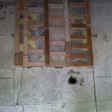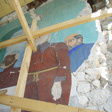St. Trinity Episcopal Cathedral
More than a year after a devastating earthquake struck Haiti, the famed murals at St. Trinity Episcopal Cathedral in Port-au-Prince have come down. A team of American and Haitians, led by conservators Viviana Dominguez and Rosa Lowinger have carefully removed the three surviving murals from the ruined walls of the destroyed Episcopal church in order to preserve them for the future.
Fourteen life-sized murals depicting scenes from the New Testament were painted on the interior walls of the cathedral in 1950-51 by eight of Haiti’s most celebrated artists associated with the Centre d’Art and its characteristic vernacular style. The murals were controversial at the time because they depicted Haitians in biblical roles, but many saw them as representing the way Haitians adapted Christianity. Only three murals survived the January 12, 2010, earthquake—“The Last Supper” by Philomé Obin, “Native Procession” by Préfète Duffaut and “The Baptism of Christ” by Castera Bazile—and all were severely damaged. Initially protected from post-earthquake demolition by warning signs and tarps, the murals became a focus of preservation efforts by the Smithsonian and the Haitian government with the permission and cooperation of Episcopal Church officials.
Haitian cultural worker and sculptor Patrick Vilaire built scaffolding to protect the murals, provide structural support for the walls, and allow the conservators the necessary work space.
In order to develop an effective way of removing the murals, Lowinger and Dominguez conducted off-site trials with potential treatment materials and scientific tests on mural fragments to determine the types of paints used on the surface and the composition of the underlying wall mortar. Fragments from each mural were sent to the Getty Conservation Institute and the Smithsonian’s Museum Conservation Institute for analysis. Tests revealed that the murals were painted using egg tempera applied on top of a very thin mineral-based ground layer. The paint is extremely powdery to the touch and it crumbles easily. Conservators concluded that the best method for saving the murals was to detach the surface painting and the layers of mortar immediately beneath it from the wall, a method known as stacco.
Taking down the murals in this manner requires the use of fixatives—typically a dilute spray consolidant—and facing materials—typically gauze—to securely bind the paint and mortar and hold them in place during removal. Tests also were conducted to find fixatives and materials that would not harm the murals. Dominguez and Lowinger also closely studied drawings and photographs of the murals to determine where to make the cleanest cuts to avoid damage.
Wood lattice was also applied on top of the facing material to provide structural stength to the murals' surface so that fragments could be removed without fracturing.
Dominguez and Lowinger worked at the site over the period of six months, training a supervising a team of Haitians consisting of Junior Norélus, Junior Racine, Wanglish Michel, and Franck Fontaine (insert names of Haitians--get from Olsen or Stephanie). The technique proved successful and the team adept.
The mural fragments have been removed from the site and are now safely stored at the Haiti Cultural Recovery Center. The team will repair and consolidate the mortar backing of each fragment to provide strong support for the surface painting. They also will remove the facing material to prevent any possible mold damage due to Haiti’s humid conditions.
Conservators will help design ways to reassemble the murals so that they can be installed on the site once a new cathedral is rebuilt by the Episcopal Church.
























